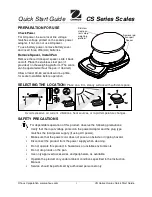
CHAPTER 2 - DIAGNOSTIC GUIDE
Valor 1000 Series Service Manual
9
Ohaus Corporation www.ohaus.com
2.2.2 Checking Load Cells for Trouble
1. Visual Check:
– Clean the unit before evaluating any mechanical problems. In some cases, debris may
have accumulated inside the Housing. Make sure there is no buildup of any foreign
material.
– Examine the unit for bent Frame or signs of physical abuse that could cause it to
malfunction. Replace all damaged parts. See Chapter 5 for parts identification.
– Check that the Down Stops are not touching the Frame. This would restrict movement,
causing improper operation. If the Down Stops are improperly set, adjust them. (See
Section 3.6.)
– Check the cables leading to the Load Cell for cuts, abrasions or other signs of
excessive wear and tear.
– Check for a bent or twisted Load Cell:
Place the top surface and then each of the
sides of the Load Cell on a flat surface, to see if it rests flat and even. A gap indicates
a bent or twisted Load Cell. A Load Cell that is even slightly bent or corroded should
be replaced.
– Examine the Load Cell for corrosion due to high humidity or exposure to chemicals.
2.
Perform a Resistance Test
, to determine if the Load Cell is severely damaged or a short
circuit to the frame has occurred.
Note:
The Load Cell must be completely disconnected from the Printed Circuit Board and
at no load when the resistance readings are taken.
Using an ohm meter, measure and record resistance between each pair of wires from the
Load Cell, as specified in Table 2-1. Compare the measured readings with the specified
values in Table 2-1.
If the resistance readings are in the range specified, skip to the next section. If they are
outside the expected range, open circuit or short-circuit across any two wires, the
Load Cell is defective: replace it. (See Chapter 3.)
TABLE 2-1. LOAD CELL RESISTANCE READINGS (in Ohms)
Ex+ to Ex
–
S+ to S
–
404 ± 10
350 ± 10
Summary of Contents for Valor 1000
Page 1: ...ValorTM 1000 Series Service Manual...
Page 2: ......













































